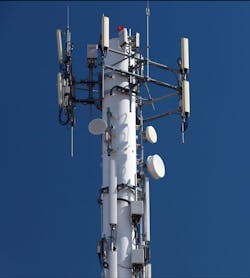Shoring Up Supply-Chain Integrity Puts Focus on IIoT Design Challenges
This article is part of TechXchange: Chip Shortages and Counterfeits
What you’ll learn:
- What are the differences challenge-wise between the IoT and IIoT?
- The role of MCUs in solving supply-chain design issues.
- Methods used to increase security.
- The rise of contactless devices.
The COVID-19 pandemic has exposed difficult challenges in global supply-chain standards that must be addressed even as the world contends with this once-in-a-century event. These challenges are refocusing many system designers away from personal biometric applications and autonomous vehicles to the specific requirements of thousands of processes and machines in the industrial space, each one in motion 24/7/365 worldwide.
Unlike the broader IoT space, which is often characterized as a collection of solutions looking for problems, the industrial IoT (IIoT) segment is focused on well-defined application areas including intelligent asset tracking, predictive maintenance, and manufacturing process optimization. Each poses its own special challenges for system designers, but all require a solid security foundation. Meanwhile, new challenges have emerged with the pandemic-spurred embrace of touchless technologies and emergence of new market opportunities, from 5G to environmental monitoring.
Comparing IoT and IIoT Challenges
While personal privacy is critical for consumer applications such as biometric tracking using IoT wearable technology, it doesn’t apply IIoT solutions to monitoring palettes of toilet paper sitting in the cargo hold of a container ship. Each IIoT category has other, generally more definitive functional targets.
For instance, the goal of intelligent asset tracking is to maintain a secure chain of custody for goods transported by any method, anywhere on the planet (Fig. 1). This concept is important to the legal system and now it’s important to global supply chains.
For predictive-maintenance systems, it’s imperative that users know when something is starting to fail before it actually does fail. A good example is HVAC service companies in large cities that keep their service vehicles rolling in waiting patterns, 24/7, so that response times are optimal (Fig. 2). Predictive maintenance will reduce the number of critical failures requiring immediate response times.
Process-optimization systems have a different requirement. They go beyond optimizing isolated portions of a product flow to provide a more holistic view of the entire process. This will likely require edge nodes and sensors that aren’t directly in the control loops. Rather, they’re positioned to observe and detect new patterns of material that are perhaps not yet obvious but can be optimized further.
A broad selection of devices is available for each of these applications. They from very small form factor 8-bit MCUs and low-power, high-integration Arm Cortex-based MCUs to RISC-V/FPGA platforms that reach over a large area of IIoT node applications.
Today’s microcontrollers increasingly deliver greater analog integration to reduce external component count and overall design footprints. They’re also supported by IDE environments, often available free of charge, include cross-platform offerings as well as hardware debugger/programmer tools. Some of these tools can provide real-time power analysis and basic logic-analyzer functions. Designers can opt for pre-certified wireless modules as well, but the industrial space tends to rely more on hardwired connections, usually via Ethernet.
To implement those connections, there’s growing demand for IEEE 1588 PTP-enabled products that move data from node to node quickly, on time, and in redundant environments. Leaders in the IoT Service provider space, such as Google, Amazon Web Services, and Microsoft Azure, also have worked with semiconductor companies like Microchip to develop low-cost evaluation kits that enable very quick and secure connections to the cloud.
Beefing Up Security
Another critical element is security ICs that scale from small MCU-based edge nodes to full-featured modules suitable for PC- and server-based platforms. Basic devices are available featuring trusted root certificates registered with the major web service providers. This enables a seamless out-of-box experience using IoT kits for connecting to the cloud.
System designers need these devices to help them maintain the entire chain of custody for both edge-node applications and the data channels they use.
Edge-node application protection must be ensured through secure boot, secure over-the-air (OTA) or physical channel updates, tamper protection, and data-memory address scrambling. This can be performed internal to today’s MCUs and MPUs, or by pairing MCU/MPUs with companion secure-element ICs that enable the use of key-based authentication to validate transactions within systems.
Combining those features ensures that the correct image is executing while being protected from contamination or replication from unauthorized external agents. Adding secure-element ICs extends the chain of trust to the sensors and actuators that the edge node is connected to, eliminating the risk of hardware spoofing.
Semiconductor suppliers also have begun offering in-house programming services that ensure maximum attention to security during the commissioning of root certificates and encryption keys. This is performed to standards acceptable to the major web service vendors.
Another important factor is data-channel protection, secured through traceable root trust certificates. This enables secure cloud connectivity and secure messaging within that secure channel. Typically, encryption key rotation is a standard security methodology. Secure-element ICs should never expose private keys external to the secure device, which facilitates implementation.
These are the basic challenges faced by every IIoT system designer. Additional challenges have surfaced during early adoption of solutions like touch-free devices spurred by the pandemic, and by applications that are in varying stages of deployment, including 5G services and environmental monitoring systems, among others.
Tapping into Touch-Free Experiences
The global COVID-19 pandemic exposed the prevalence of human contact among buttons and touchscreens. The amount of hand sanitizer being used to mitigate exposure brought contactless user interfaces into the forefront, and the IoT and IIoT are both expected to lead the charge toward contactless and smart devices.
Despite the availability of both discrete turnkey touch controllers, integrated MCU solutions, and devices featuring 3D gesture-recognition technology, key challenges include finding the right balance of noise suppression vs. sensitivity in high electrical noise environments such as industrial plants. The ability to add the required low-cost, low-power computing power to these local sensors increases detection accuracy and lightens the load on the IoT network, while increasing autonomous error-correcting behavior. Active or passive shielding of sensor pads and fusing optical sensors with capacitive sensors extends the accuracy of these systems.
Billions of nodes on the internet, each generating small data packets, is a worst-case routing scenario. Finding the optimal balance between edge-node intelligence and reliance on a persistent cloud connection will be a challenge for a while. The infrastructure required to properly steer all of these small packets in some type of deterministic way presents a very different routing challenge than streaming a movie.
Major IoT cloud vendors have set up their own network backbone structures to address routing latency and reliability, putting more pressure on the local providers to match the same quality of service (QoS). Fortunately, a 100-ms delay in a home security response time isn’t a problem that needs to be solved.
Navigating New IIoT Growth Areas
The introduction of 5G in a widely available form creates new IIoT business opportunities. However, it also continues to slow down some aspects of this sector’s growth because mobile vendors made promises they weren’t keeping in terms of available bandwidth and coverage (Fig. 3).
Now that decent NB-IoT and LTE-M coverage is starting to become more available, the proper partitioning between these two complementary technologies will dictate some semiconductor-industry trends as users need to choose between the performance tradeoffs of the two technologies. Evaluation boards combining various flavors of MCUs and RF chipsets are starting to appear on the web as these new RF topologies compete in some cases with LoRa implementations.
Another interesting growth opportunity has been environmental monitoring beyond the standard weather station offering. The bush fires in California along with the current interest in post COVID-19 indoor CO2 levels have expanded air-quality monitoring complexity.
The need to correctly measure air pollution levels reliably is a growing challenge in the sensor market. An interesting thing to observe during last year's bush fire cycle was the disparity in air-quality readings between different networks from the same location. This was due to different methods of measurement at the sensors as well as data presentation (units, types of particles). As they say, standards are wonderful things, everyone should use them.
Turning the Page
As the world moves through and beyond the global pandemic, among the indelible marks will be a greater focus on supply-chain integrity and the growing adoption of touchless technologies. IIoT technology will help fuel these trends along with the rollout of 5G services, environmental-monitoring solutions, and other offerings that rely on edge nodes and sensors for control and basic tracking as well as to observe and detect behavioral patterns.
Semiconductor companies will continue to innovate and solve the system design challenges associated with these and other applications as a continuous response to the post COVID-19 world. And the products they release will enable more cost-effective solutions that are easier to deploy.
Read more articles in TechXchange: Chip Shortages and Counterfeits



